Did your craft-freak friend ever dare you to tell the difference between two prints? Well, my friend did and unfortunately I failed. One of the prints was infusible ink and the other was sublimation. As a newbie at that time, I had no clue about infusible inks or sublimation.
If you’re in that confusing state like I was a few years ago, you’ve come to the right place. In this article, I’ll explain in and out of infusible ink and sublimation. You’ll learn why these two prints look similar and what are their differences.
So, first, let’s solve your confusion.
Is Infusible Ink The Same As Sublimation?
Yes, infusible ink is almost the same as sublimation. In both cases, you have to use a heat press to transfer the ink to the substrate.
The only difference is in the preparation phase. You need to create the sublimation design sheet in sublimation whereas the infusible inks come in pre-cut sheets. This means infusible ink is a simple version of sublimation.
You can use infusible ink printing or sublimation for making personalized gifts, custom fabrics, home decor items, and promotional items. We’ll discuss these applications later in this article.
But first, you need to understand what infusible ink is.
What Is Infusible Ink? (Cricut Infusible Ink Sheet)

Infusible ink is a transfer-ink product that embeds straight into the substrate using a heat press. Unlike vinyl or HTV process, infusible ink gets infused in the material at optimum temperature.
Cricut introduced infusible inks first in June 2019 to make the sublimation process easy. The inks come in sheets, pens, and markers allowing artists to be more creative with the sublimation process.
If you want to dive deep, Cricut Infusible Ink Sheets are patterned designs and colors pressed on a sublimation transfer paper. You need to cut the design with a die-cutting machine first. Then, using a heat press, you can transfer the dry infusible ink on a substrate.
Kinda seems like the sublimation process, huh? Well, don’t worry, I’ll clear up your confusion in the next segment.
What Is Sublimation?
Sublimation is a process that transforms solid matter into gas by using the appropriate amount of heat.
This process is used in sublimation printing where you can transfer sublimation ink to a substrate using a heat press. Of course, the level of temperature, pressure, and time depends on the substrate material.

So, the heat press part is similar for both the sublimation and infusible ink process. But the actual difference lies in the preparation phase.
Now, the infusible inks come in a sheet where you need to weed out the design first. On the contrary, you must print the design on a sublimation printer and then put it in the heat press for sublimation.
Note that sublimation ink is a dye-based ink. It can transfer into any type of substrate (e.g., metal, glass, ceramic, polyester fabric, and wood.). But you must maintain a specific temperature in the heat press required for each material.
Comparison Table: Infusible Ink Vs Sublimation
So, to draw the whole picture for you, I’ve added a side-by-side comparison table. By skimming through the table below, you’ll understand how the two processes differ from each other.
| Factors | Infusible Ink | Sublimation |
| Design Printing Requirement | Infusible inks come in pre-printed Cricut Infusible Ink Sheets. Only requires designing the shape of the design. | You need to print your preferred design on transfer paper using a sublimation. printer. |
| Color and Patterns Options | Limited to only manufacturer colors and patterns. | Offers room for unlimited creativity. |
| Cutting Machine Requirement | Requires a die-cutting machine for cutting the designs. | Doesn’t require any cutting machines. |
| Printer Requirement | Doesn’t need a printer for the design. | Needs a sublimation printer to print the design. |
| Investment Cost | Has a low upfront cost but becomes expensive for long-term printing. | Has a high investment cost but the costs reduce in the long term. |
8 Key Similarities – Infusible Ink Vs Sublimation
Despite having differences, we already mentioned the infusible inks are almost similar to the sublimation process.
So, here are the 8 key similarities between infusible ink and sublimation explained in detail below.
Heat Transfer Process
Infusible ink and sublimation inks are solid, dehydrated inks. Both of them require around 385-400℉ temperature to transfer ink on the substrate. The press time should be around 6 seconds.
Now, you need to be careful about providing the correct amount of heat and pressure. If you apply more or less than the optimum level, you won’t get the desired print. It’ll either come out faded (less heat) or the print will crack (more heat).
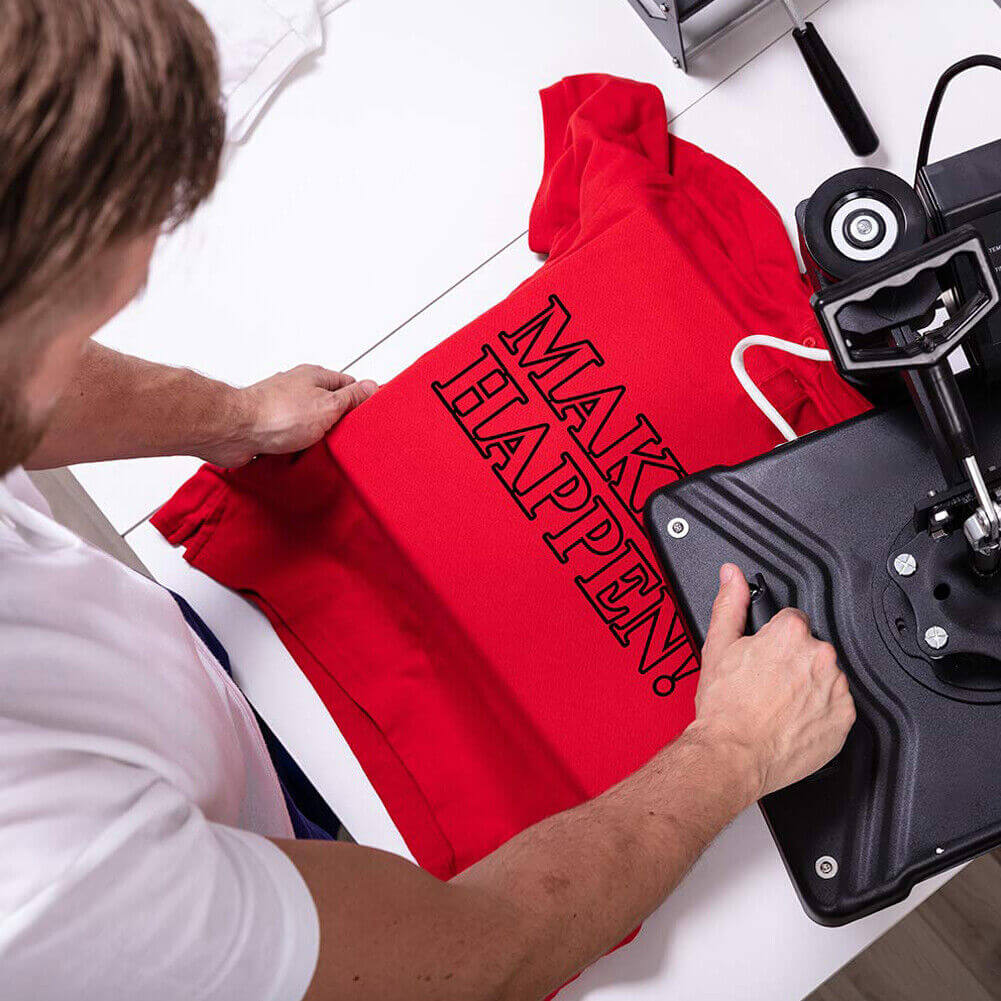
Vibrant Colors
Both infusible and sublimation ink look muted before applying the heat press. They seem to look a little flushed in the beginning.
But after you finish the infusing or sublimation process, the designs come out in fresh, vibrant colors. You’ll get a color vibrancy that looks almost similar to the original image. However, both of them work best on white or light-colored substrates.
Image Quality
You can get high-quality images in both of the printing processes. The details and gradients come out excellently with vivid colors.
You can use infusible pens and markers to draw more complex designs on the Infusible Ink Sheets. Well, for sublimation, you need to design complex designs before printing them on transfer paper. The outcome looks absolutely like the original image.
Durability
Now if you maintain the correct time, temperature, and pressure, both infusible ink and sublimation will sustain for a long time.
The ink gets permanently attached to the material with heat. So, the ink becomes durable and doesn’t fade, peel, or crack too easily. The color vibrancy also remains intact for years.
Versatility
You can be as creative as you want with these two processes. Infusible ink and sublimation inks support almost all kinds of materials such as fabrics, ceramics, wood, glass, and metals.
You can create custom designs on these surfaces. In short, the infusible ink and sublimation provide excellent versatility.
Permanent Bond
Both infusible ink and sublimation ink turn from fluid to gas under heat and pressure. As a result, they create a permanent bond with the substrates.
The bonding is so strong that they become resistant to regular wear and tear, wash, or exposure to any other external elements.
Washability
As the inks infuse inside the substrate, you can easily wash the item. There’s no risk of fading, peeling, or cracking for any of the printing processes.
The best part is infusible ink or sublimation both approve dishwasher washing. So, if you want to clean your sublimated dishware items, you can do it without worrying about it.
DIY Application
You don’t require any heavy industry machinery for printing with infusible ink or sublimation. Both of the printing processes support DIY (Do-it-Yourself) applications.
The application process is fairly simple and doesn’t require any professional expertise. So, if you’re a hobbyist or a small business owner, you can try both of the processes with minimal effort.
8 Key Differences – Infusible Ink Vs Sublimation
It’s time we talk about the differences between the two processes. Here are the differences explained in detail below.
Printing Process
There’s only one step difference between the printing process of infusible ink and sublimation. Infusible inks come in pre-cut sheets. You need to weed out the negative spaces before printing the design on the material.
But for sublimation, you don’t need to cut any part of the design. You can simply attach the design with heat-resistant tape on the substrate and sublimate it with a heat press.

Surface Feel
Infusible ink printing feels smoother than sublimation printing. It’s because infusible ink directly creates a bond with the fiber of the material.
Though sublimation also embeds in the material, the dye creates a textured feel. However, the slightly raised texture is almost non-existent. So, it doesn’t feel discomforting.
Color Options
As infusible ink comes in a pre-cut sheet, you’ll get fewer color options than sublimation. You can still add details using infusible ink pens and markers.
On the other hand, sublimation has a wide range of color options. You can choose complex gradient designs and they’ll look just like the original image in sublimation printing.
Equipment Requirements
Infusible inks require a die-cutting machine (e.g., a Silhouette machine) to cut the edges of the infusible sheets first.
There’s nothing called an infusible ink printer in this case. But the sublimation process doesn’t require any cutting machine. Instead, you’ll need a sublimation printer to print out the design.
This is the main equipment difference between the two processes. However, after the designs are ready, both of the processes will require compatible polymer substrates and a heat press.
Image/Designs
You can create intricate designs with sublimation but it’s hard to do it with infusible ink. It’s because infusible inks already come in pre-cut designs. But you can expand your creativity and print your own design in sublimation.
Again, layering multiple images for infusible ink doesn’t turn out as good as you’ll get it in sublimation printing. The images looked a little flushed for multiple-layering infusible inks.
Cost
If you’re just starting out and don’t have a sublimation printer, the infusible ink process will be less expensive for you. The Cricut Infusble ink sheets come less in price than sublimation prints.
However, if you have a sublimation printer at home, you can save up to 50-60% compared to the infusible ink process. As the upfront investment is only a one-time deal, the average printing cost lowers in the sublimation process.
Setup Time
You’ll need less setup time in the infusible ink process than in sublimation. It’s because infusible ink sheets, markers, and pens are already available.
But for sublimation, you’ll require additional time designing and printing the sublimation paper. The rest of the printing time is almost the same for both of the processes.
Availability
Infusible inks are limited to Cricut suppliers only. However, you’ll find sublimation blanks, printers, and heat press widely available in any crafting store. So, sublimation products are more available than infusible inks.
Advantages & Disadvantages – Cricut Infusible Sheets vs Sublimation Printing
So, now you should learn what are the pros and cons of each process. To help you determine the best printing choice, here are the advantages and disadvantages listed below.
Cricut Infusible Sheets Advantages
- They already come in pre-cut designs. So, you can save design preparation time in the case of Cricut Infusible Sheets.
- They are extremely durable; won’t peel or crack after multiple washes.
- These infusible sheets support any kind of polyester substrate.
- They save you time and money if you have a Cricut machine.
- You can add details to the sheets using infusible inks and pens.

Cricut Infusible Sheets Disadvantages
- Layering multiple colors with infusible ink is hectic to do.
- This process is expensive if you don’t have a Cricut machine.
- As it comes in pre-cut design sheets, the color options get limited.
- Using the heat press multiple times results in a faded design.
- The Cricut Infusible sheets are only limited to Cricut blanks.
Sublimation Printing Advantages
- Applying the correct temperature and pressure makes the sublimation print permanent.
- You can easily wash sublimated dinnerware items in a dishwasher or put them in a microwave.
- You don’t need to cut or weed out any designs before using the heat press.
- You can be as creative as you want with the designs in this printing technique.
- You can use standard inkjet printers for printing sublimation designs.

Sublimation Printing Disadvantages
- Sublimation printers are expensive as upfront startup costs.
- It’s not compatible with cotton fabrics.
- You can’t undo any mistakes on the substrates.
- Generally, sublimation is compatible with light colors only.
- The process is longer than the Cricut Infusible Ink printing as it takes time in preparing the designs.
Use Cases and Applications
So, now that you have an idea about the infusible ink and sublimation process, let’s dive into applications. Keep reading the segments below to learn what you can create in each process.
Infusible ink applications
Infusible inks support almost all kinds of materials including fabrics, ceramic, glass, and wood. You can create awesome clothes, home decor items, and personalized gifts with this process.
In the next segments, I’ll explain what you can do with infusible inks.
Garments and Apparel
You can create exquisite designs on fabrics with infusible inks. This type of printing process is used for custom-designed t-shirts, tank tops, hoodies, and sweatshirts. But you have to make sure the material is polyester or mostly polyester fabrics.
Home Decor
Interestingly, you can use infusible ink for home decor items as well. They bring a great addition to custom pillow covers, wall art, ceramic tiles, cutting boards, and tea towels.
For this, you need to choose light-colored materials. White and pastel colors are perfect for using infusible ink in home decor projects.
Personalized Gifts
Apart from decorating your home, you can also create custom gifts with infusible inks. You can make Christmas ornaments that will light up the mood at Christmas.
On the other hand, you can also make personalized tote bags, picture frames, cutting boards, keychains, mugs, and coasters with infusible inks.
Sublimation Applications
Like infusible inks, sublimation also supports a variety of materials. For example, you can sublimate on polymer-based fabric, ceramic, metal, acrylic, wood, plastics, fiberglass, and glass.
So, there are endless options to create customized products with sublimation. Here’s what you can use this printing process for.
Customized Products
If you have a sublimation printer and a heat press, you have many options to sublimate customized products.
You can create your own design and sublimate it on your favorite substrate. The best-customized products you can create with sublimation are apparel, home decor items, accessories, bags, towels, signs, and blankets.
Promotional Items
For businesses, sublimated items can work as excellent souvenirs. These items can help promote your business.
Whether you’re promoting your business or your client’s business, sublimation helps a lot. Here are a few examples of promotional items that you can sublimate – placemats, mouse pads, beverage insulators, coasters, mugs, keychains, and puzzles.
Photo Printing
If you love framing photos, sublimation also gives you the option to print high-quality images. You can photo print through sublimation using any kind of sublimation paper. You need to test the ink quality before printing large quantities to keep up the quality.
3 Samples of Infusible Ink Sheets
1. Lucky Goddness Watercolor Infusible Ink Sheets
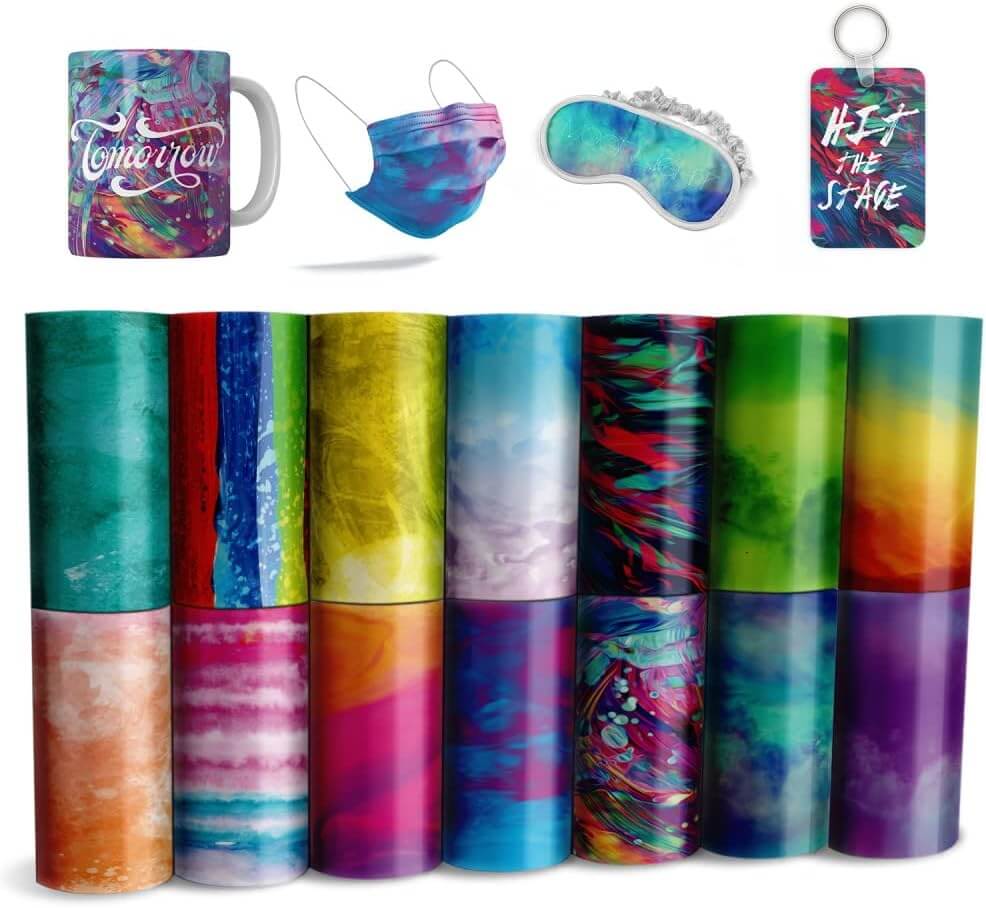
The Lucky Goddness Watercolor Infusible Ink Sheets are perfect for making hand-made gifts. Generally, the ink looks muted but after applying the heat press, it appears vibrant on the substrate.
You can use polyester T-shirts, leather earrings, mugs, mouse pads, puzzles, pillows, phone cases, car coasters, tote bags, keychains, and pet bandana dog scarfs as infusible ink blanks for this ink.
As per the manufacturer’s instructions, you should use tweezers for weeding to protect the design.
2. Cricut Infusible Ink Sheets

The second infusible ink sheet you’ll want to check out is the Cricut Infusible Ink Sheet. These sheets come in solid colors. You can cut them with a Cricut machine and infuse them in Cricut blanks.
They come in 12in x 12in (30.5 cm x 30.5 cm) size. Additionally, there are 2 butcher papers for protecting other materials during the ink sheet transfer. They support all types of substrates that you can sublimate on.
3. Cricut Infusible Ink Transfer Sheets (Distressed Cool Water Pattern)

Here’s another infusible ink from Cricut – the Cricut Infusible Ink Transfer Sheets. Unlike the previous Cricut infusible ink sheets, these transfer sheets come in water patterns.
You’ll find multiple hues of blue and teal on these sheets. If you prefer patterned colors to solid colors, this infusible ink transfer sheet will be the best option for you.
But remember that these sheets are compatible with Cricut Maker and Cricut Explore family machines only.
3 Samples of Sublimation Inks
1. Hiipoo Sublimation Ink
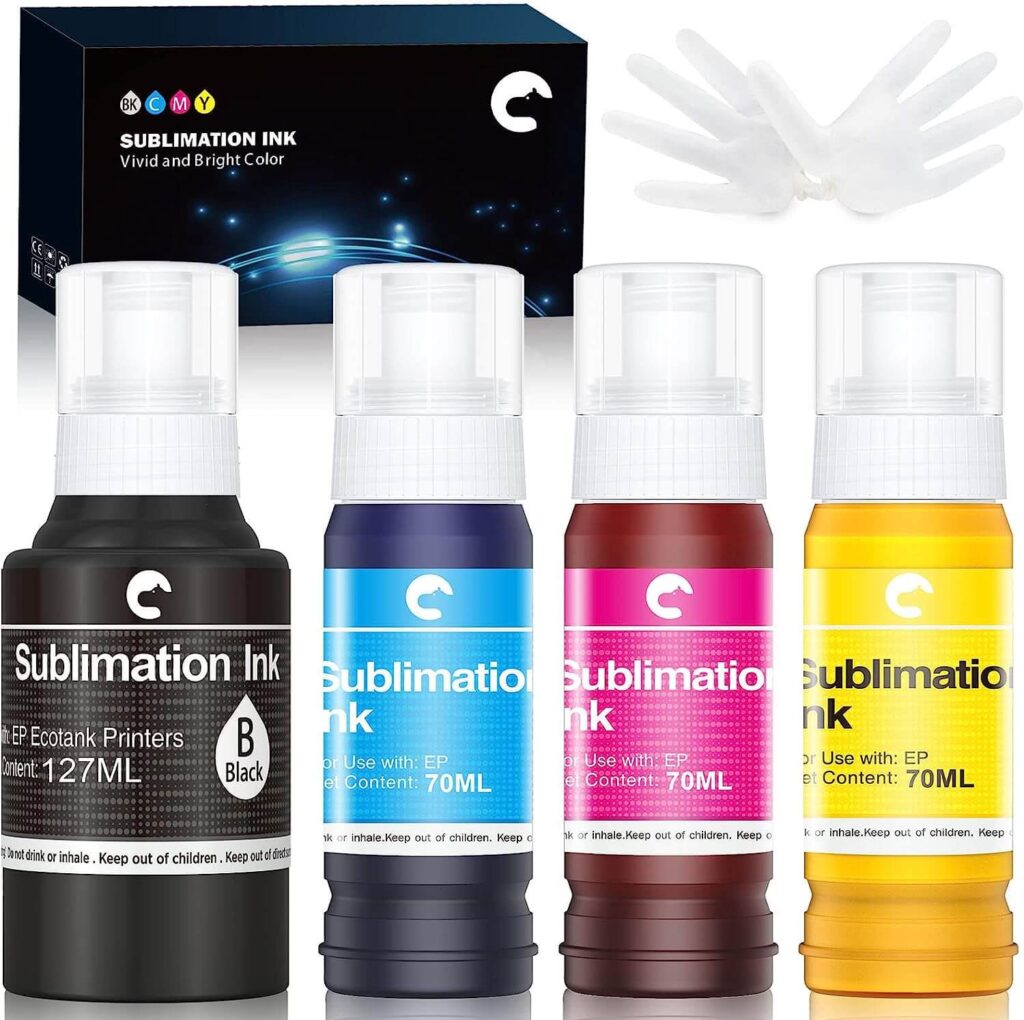
Hiipoo Sublimation ink is widely popular among sublimation enthusiasts. Its easy application, output texture, and color accuracy is the reason for its popularity.
You can sublimate mugs, polyester fabrics, ceramics, boxes, flags, and banners easily with this sublimation ink. The best part of this sublimation ink is the packaging that prevents ink from clogging up. So, every time you sublimate, you receive a smooth textured finish.
2. Hiipoo Sublimation Ink Refilled Bottles
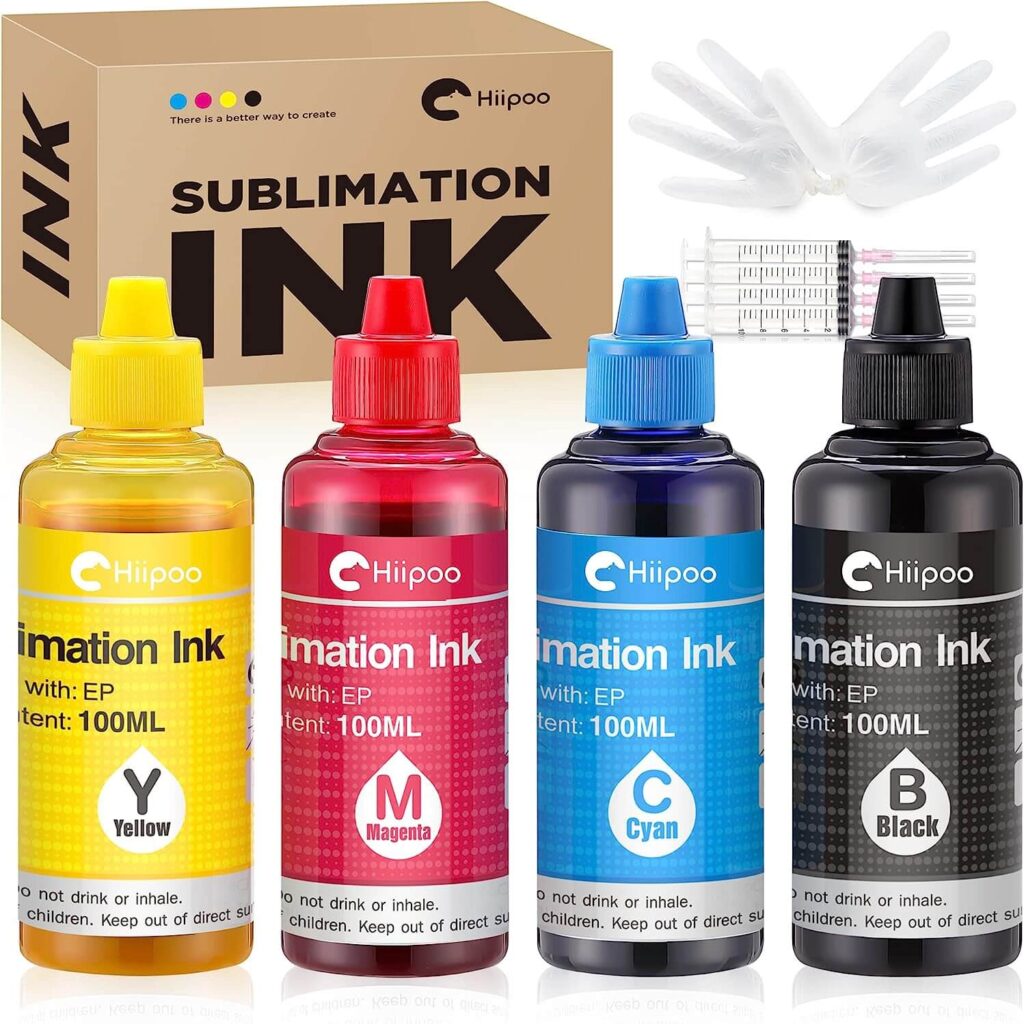
Here’s our second favorite sublimation ink – the Hiipoo Sublimation Ink Refilled Bottles. These sublimation ink are waterproof. This means the dye doesn’t wash away with water on the item.
Again, this water-based sublimation ink has a high transfer rate. You can save time working with this sublimation ink.
According to the manufacturer, you can print 3000 sublimation papers with this package (4 color bottles). So, it definitely indicates a good value for investment.
3. Tonha Sublimation Ink Refill
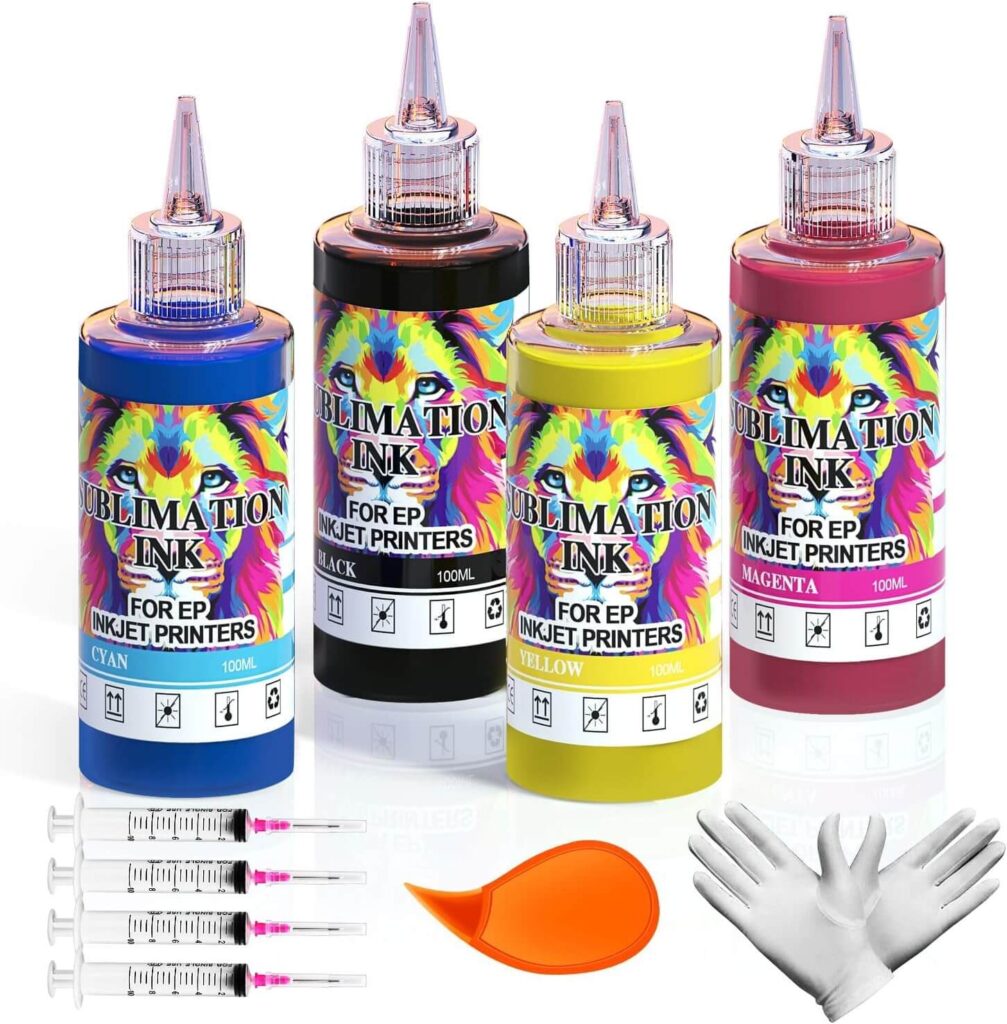
Finally, Tonha Sublimation Ink Refill will also win your heart as a sublimation ink. It’s compatible with Epson EcoTank Inkjet printers.
The ink adds a thermal sublimation coating on the surface of the substrate. So, the sublimation print becomes water-resistant and light fastness.
You can trust the color vibrancy of this ink also as there’s no need for additional ICC correction. Overall, it’s the perfect sublimation ink refill for under $10.
FAQs
Can I use infusible ink and sublimation on the same material?
No, you can’t use infusible ink and sublimation on the same material. It’s because both of the methods have different temperatures, pressure, and time requirement depending on the substrate.
Though these two processes support the same kind of materials (metal, wood, fabric, ceramic, etc.), you can’t use them interchangeably.
Can I use infusible ink or sublimation on dark-colored fabrics?
No, you can’t use infusible ink or sublimation on dark-colored fabrics. The reason is that these inks have low concentrations. So, when you use them on dark-colored fabrics, they won’t show up.
If the fabric has a high percentage (more than 60%) of polyester, it might show up but look faded.
Can you sublimate on Cricut Infusible Ink?
No, you can’t sublimate on Cricut infusible ink. If you do so, you will not receive the desired outcome. It’s because each process has different kinds of limitations and requirements.
Do you need a printer for infusible ink?
No, you don’t need a printer for infusible ink. They come in pre-cut sheets with solid colors and patterned designs. You can use them directly for cutting in a Cricut cutting machine.
Can you use Cricut Infusible Ink on regular shirts?
No, you can’t use Cricut Infusible Ink on regular shirts if they’re made of 100% cotton. But if your shirts contain a high percentage (more than 60%) of polyester, you can use the Cricut Infusible ink on them.
Does Cricut Infusible Ink last?
Yes, Cricut Infusible Inks last for years. These inks infuse into the material by a heat press, creating a permanent bond with the substrate. So, the ink becomes peel-proof, crack-proof, and wash-proof.
(Cricut) Infusible Ink vs Sublimation: Which One is Better for Your Projects?
Hopefully, you’re now clear about the query – “Is infusible ink the same as sublimation?” Of course, both of the printing processes have similarities and dissimilarities. Finally, it boils down to one question – which one should you go for?
Now, there’s no correct answer here as it totally depends on your situation. By analyzing from a general point of view, I’d say go for the infusible ink if you’re just a beginner.
But if you already have a printer that works just fine as a sublimation printer, opt for sublimation. It’ll save you more time and money than infusible ink in the long run.